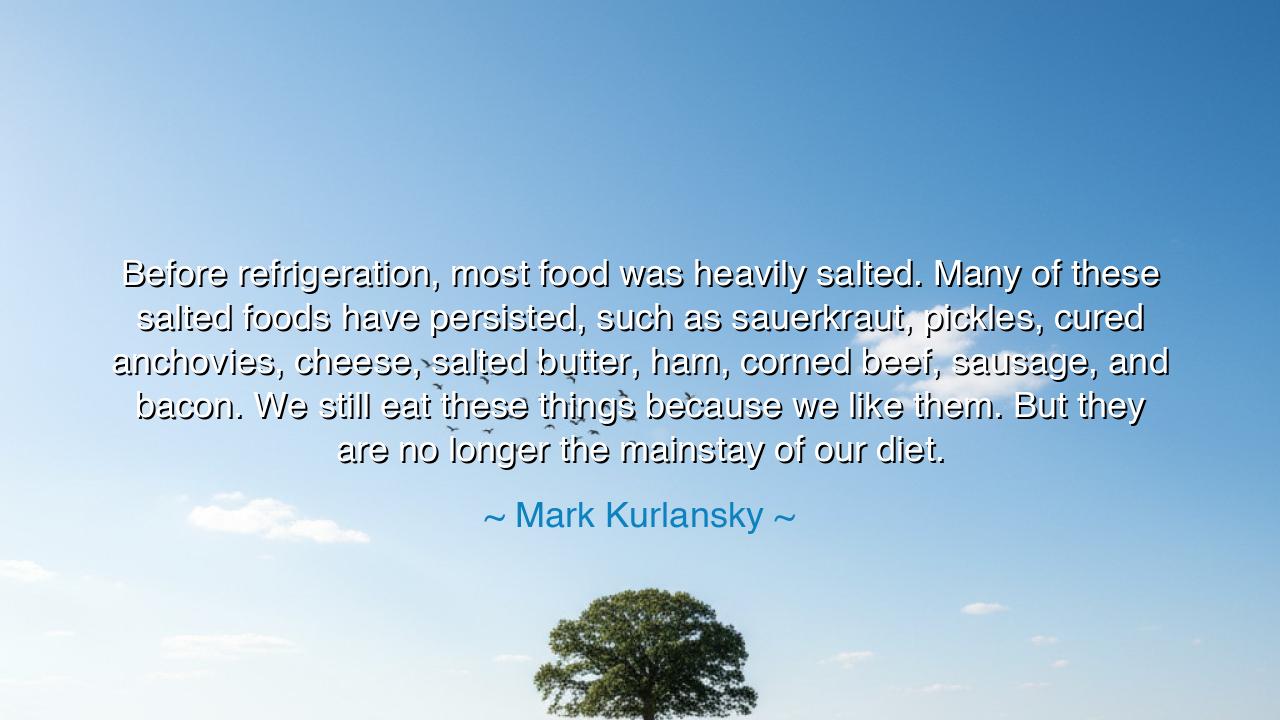
Before refrigeration, most food was heavily salted. Many of these
Before refrigeration, most food was heavily salted. Many of these salted foods have persisted, such as sauerkraut, pickles, cured anchovies, cheese, salted butter, ham, corned beef, sausage, and bacon. We still eat these things because we like them. But they are no longer the mainstay of our diet.






Hear now the words of Mark Kurlansky, a modern chronicler of history and food: "Before refrigeration, most food was heavily salted. Many of these salted foods have persisted, such as sauerkraut, pickles, cured anchovies, cheese, salted butter, ham, corned beef, sausage, and bacon. We still eat these things because we like them. But they are no longer the mainstay of our diet." These words carry with them a profound truth about how the habits of our ancestors shape the way we live today, and how what was once necessary for survival can become, over time, a matter of choice. The act of salting—once essential for preserving food—now exists as a marker of tradition, a taste of the past that lingers in our modern meals.
In the ancient world, salt was not merely a seasoning; it was a means of survival. The great civilizations of Egypt, Rome, and China understood the value of salt, for it was the key to preserving their food for long journeys, for the winter months, and for times of scarcity. Homer, in his epic Odyssey, wrote of salt’s significance not just as a commodity, but as a symbol of the struggle for life and sustenance. To salt food was to ensure that it could be kept, that the body would not go hungry when the harvest was gone, or the game scarce. Mark Kurlansky reminds us that what began as a means of survival—salted food—became woven into the fabric of cultures, becoming a symbol of human ingenuity and resilience.
Consider the Roman Empire, which flourished because its armies, and its citizens, were able to preserve food through the use of salt. The soldiers of Rome were paid in salt, a practice that gave rise to the term “salary.” Without the preservation that salt provided, their empire might not have lasted as long as it did. Salted fish, salted meats, and other preserved foods allowed the Roman legions to march across vast territories, never uncertain of where their next meal might come from. Kurlansky’s words resonate with this ancient truth: the salted foods that we still consume today are the heirs of a long history, passed down through generations not just for their taste, but for the sustenance they once provided in times of need.
Yet, salted foods, once the cornerstone of survival, have become, over time, less of a necessity and more of a tradition—a connection to the past. The advent of refrigeration and modern preservation methods changed the way we think about food. Where once salt was the guardian of life, it is now often seen as a flavor to be enjoyed in moderation, but not relied upon for survival. The rise of the modern kitchen, with its appliances and refrigerators, has freed us from the need to salt our food to preserve it. And yet, the taste of those salted foods, the familiarity of bacon, pickles, and cheese, still calls to us, offering a glimpse into the history of how our ancestors lived and thrived.
In the same way, the ancient Greeks understood the need to preserve food, not just through salt, but through other means such as drying and fermentation. Their diet, like that of the Romans, was based on what could be kept for long periods—preserved grains, salted fish, and cheese were staples in the ancient Mediterranean. Kurlansky’s reflections on how these foods have persisted through the ages speak to the lasting power of tradition. What began as an essential means of survival has now become a choice, a delight that links us to the past, to the age-old methods that allowed our ancestors to endure and flourish.
The lesson that Mark Kurlansky imparts is not just one of food history, but of balance—the balance between necessity and pleasure, between what we need to survive and what we choose to enjoy. Just as salt once symbolized the struggle for survival, it now represents the beauty of preservation and the joy of connection to our shared heritage. Yet we must not forget the role of moderation, as we consume these foods not out of necessity, but because they remind us of a time when survival depended on the methods we now celebrate.
Thus, O future generations, let this wisdom guide you: cherish the traditions that have been passed down through time, for they are a connection to the perseverance of those who came before us. But understand that progress has allowed us new ways to live, to nourish ourselves without reliance on the methods of old. Embrace the taste of history, but also be mindful of balance in your consumption. The salted foods of our ancestors are gifts of their ingenuity, but the true lesson lies in how we move forward, honoring their wisdom while shaping our own path toward health and sustainability. In this way, we honor both the past and the future in every bite we take.






AAdministratorAdministrator
Welcome, honored guests. Please leave a comment, we will respond soon